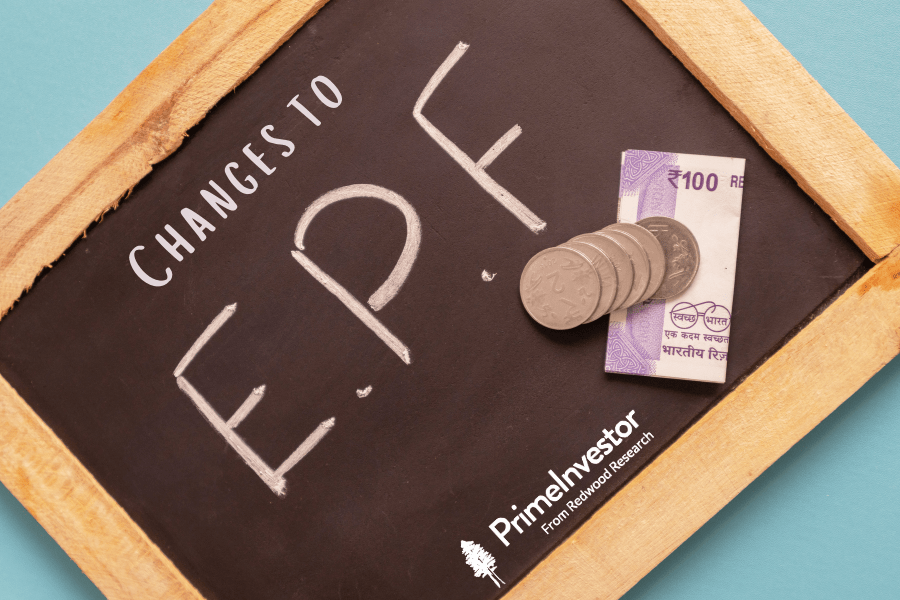Watch Aarati and Vidya talk about the recent EPF changes here.
If there’s one thing that governments love to do with their annual Budgets, it is to confuse ordinary folk with rule changes that have plenty of the fine print. This time, the change that has set off a confusing debate has been the budget proposal to limit the tax breaks on the Employees Provident Fund (EPF), the favourite retirement savings vehicle for many salary-earners. So, with these EPF changes, what changed for subscribers in the 2021 Budget? Has the government now relaxed those provisions in the Finance Bill? What is the government trying to do to the EPF overall and should you be looking at alternatives to it? We answer these questions and many more here.

What did the Budget change?
Here’s how Employees Provident Fund Organization (EPFO) works in India.
- All establishments employing over 20 workers are supposed to compulsorily enroll them in the Employees Provident Fund Organization (EPFO) and offer their employees a contribution that is equal to 12% of their basic pay plus DA.
- Rs 1250 of the employer’s contribution is diverted into the Employee Pension Scheme while the rest remains with EPF.
- The employee is supposed to match this 12% contribution every month, while those who wish to contribute more can do so voluntarily.
- At the end of every year, the government declares an interest rate that is credited to every EPF subscriber on this combined balance.
- All this money keeps accumulating in your EPF account until you retire, when it is paid to you as lumpsum.
Until recently, the EPF enjoyed an EEE tax treatment. That is, your contributions and your employer’s contributions into the fund were exempt from tax – that is – the investment enjoyed deduction, the interest credited every year was tax-free too and so were the final maturity proceeds.
In the February 2021 budget, however, the government brought in changes to say that for employees who contributed more than Rs 2.5 lakh a year to ‘recognized and statutory provident funds’, the interest earned on the extra contributions would be taxed at their slab rates. EPF and PPF are recognized provident funds. This change did not affect the Public Provident Fund because the PPF caps your annual contribution at Rs 1.5 lakh.
Only EPF and some other types of provident funds used by government employees were affected because these allow higher contributions by employees. So, with effect from April 1 2021, if your own contribution to the EPF is higher than Rs 2.5 lakh a year, the interest earned on it will be added to your income for the year and suffer tax at the slab rate.
For example, if you make a Rs 3 lakh contribution to EPF in FY22 and the government declares 8.5% interest for the year, Rs 4,250 (50,000*8.5/100) will be added to your income for the year, just your interest from bank deposits, and taxed.
EPF Changes – Why did they do this?
The government believes that apart from you and me, many super-rich folks are parking money in the EPF to earn high tax-free returns. It shared data saying that high net worth individuals had 1.23 lakh accounts in EPF with balances of Rs 62,500 crore. The EPF has been regularly declaring interest rates that are far higher than rates on most fixed income instruments. Given that the scheme is government backed, it scores high on safety and yet pays more than small savings schemes as well as long-term government securities. The tax-free interest is a further sweetener. It felt that by restricting the tax exemption on interest only to those subscribers putting in upto Rs 2.5 lakh a year, HNIs could be made to at least pay tax on interest on their much larger contributions.
Has this proposal been passed into law?
Yes, it has, in the Finance Bill 2021 that was passed by the Parliament last week.
Given that Indian employees are woefully short of retirement savings, there was a lot of criticism of this move to tax interest on EPF. The Finance Minister said that she was open to reviewing this proposal.
But in the amended Finance Bill, only a minor tweak has been made in this provision. The amendment says that if a person contributes to a provident fund “in which there is no contribution by the employer”, then contributions upto Rs 5 lakh can enjoy tax-free interest instead of contributions upto Rs 2.5 lakh. (Refer to this link for the amendments).
While varying interpretations of this have surfaced, the most credible one seems to be that the Rs 5 lakh limit on tax-free interest will apply only to General Provident Fund subscribers and not to EPF subscribers. General Provident Fund is a fund that is open only to government employees. The employer (the government) does not contribute to this fund because since 2004, it has been making its employee PF contributions to the NPS.
Does the recent amendment providing a higher limit of Rs 5 lakh apply to VPF?
While some folks have interpreted this to mean that voluntary EPF contributions by employees, which are not matched by their employer, will also qualify for this Rs 5 lakh limit, the wording of the amendment suggests that the restriction is not about employer contributions matching employees, but about the fund having any contributions from the employer at all. Even if you make VPF contributions, your EPF account will feature your employer’s contributions. This will disqualify you from the Rs 5 lakh limit. This official statement further clarifies this interpretation : (https://www.thehindubusinessline.com/money-and-banking/only-subscribers-of-gpf-dedicated-pension-funds-eligible-for-5-lakh-limit/article34152369.ece)
Should I stop my EPF contributions or curtail them?
No, you shouldn’t, for the following reasons:
- The interest rates being declared on the EPF are still far higher than anything available on comparable instruments. For FY21, the EPF’s Central Board of Trustees has just proposed an 8.5% interest (this is yet to be approved by the Finance Ministry).
- This compares to the PPF’s rate of 7.1% for the January to March 31 2021 quarter, the 6.12% yield on the 10-year central government security and the 7.15% interest on GOI’s Floating Rate Savings Bonds.
- These are instruments comparable to the EPF on safety as they are sovereign backed. History suggests that the EPF’s interest rates in the past have remained consistently high and have been immune to downturns in the domestic rate cycle too.
This suggests that the EPF remains a good parking ground for retirement savings based on its returns alone, whether or not those returns enjoy a tax-free status.
Should I simply max out my VPF contributions then, and rely on the EPF alone for my retirement?
No, you shouldn’t. We believe that while the EPF is a good option (today) for the debt portion of your retirement savings, it should not be your sole vehicle to accumulate a good corpus towards retirement. We say this on three counts.
- One, while the EPF has so far been declaring far better rates than comparable instruments, there’s no guarantee that it will do so in future until you retire. The fund declares its interest every year based on the surplus that its trustees find in its income account at the end of the year. Unlike NPS (which declares a daily NAV) or PPF (which gives you a government-guaranteed return), how the EPF calculates its annual surplus and declares high interest rates, is a black box. The fund doesn’t follow accrual accounting, its doesn’t mark-to-market its portfolio and the CAG (the government auditor) has in the past found holes in its accounting practices. Past CAG reports have also highlighted the gap between the portfolio returns being earned by the EPF and the interest it declares. All this affects the visibility of EPF’s returns in future. In contrast, there’s less uncertainty attached to returns from the PPF (which are linked to prevailing g-sec yields) and NPS (which are NAV based and market linked).
- Two, given the high interest payouts, the government also appears to be looking at nudging middle income and higher income folks towards alternatives like NPS for retirement savings, while focusing the EPF mainly on lower income earners. In the last budget for example, it said that where employers contributed over Rs 7.5 lakh into the PF accounts of their employees (EPF, GPF, superannuation, NPS all put together), the excess contributions would become taxable. The 80C benefits on EPF contributions are one of the exemptions that you need to forego to opt for the new personal tax system with lower rates. These policy tweaks suggest that EPF rates and taxation could get less attractive for bigger contributors in future.
- Three, should the EPF’s interest rates be brought down in future, you would have very little flexibility for you to pull out your accumulated money and invest it elsewhere for better returns. Its withdrawal rules are complicated to say the least, and mostly force you to hang on until you turn 58. All these factors argue for you to use EPF as one of the components to your retirement savings and not your only component. Ideally, if you plan Rs 100 in retirement savings for the year, invest no more than Rs 20-25 in the EPF.
Where do I put the other 75-80%?
Depending on the number of years you have left to retirement, you should decide on an equity-debt allocation for retirement savings as well. If you have 10 years plus to retire, your equity contributions can be at a high 75-80% to ensure that this portion does beat inflation. This equity part can go into SIPs in broad market index funds like Nifty100 and Nifty500 funds, Nifty50 and Nifty Next50 funds as well as well-rated multicap funds recommended by us.
Refer our passive fund recommendations in Prime Funds or check our recommended list of Prime ETFs. For the debt portion, we suggest that you use the NPS’ C&G portions This article explains why they’re good for your retirement savings. In addition, even if you are a salary earner, it makes sense to have a PPF account in addition to your EPF, invest regularly in options like GOI Floating Rate Bonds (if you need the interest income) or use high-quality debt mutual funds picked from our long-term debt recommendations, to earn tax efficient returns.
If you are less than 10 years away from retirement, you can have a more debt-heavy portfolio (say with a 20-30% equity component), where the EPF can make up say, 50% and NPS/GOI bonds the rest.







27 thoughts on “Confused about recent EPF changes? Here’s what you need to know”
Mam,
My question is
This new rule is applicable from 1st April 2021 onwards, suppose PF+VPF=25000/pm=3L/yr. so excess amount is 50k. Now everywhere i can see 50000*8.5%= Rs.4250(the employee to has to pay tax as per his incometax slab, this i understood. But my question is who will deduct, is it employee itself, will deduct as part of Monthly Tax computation or EPFO itself –> if so, in the same year or next consecutive year). Becoz EPF interest for the previous year is announced in the subsequent year and also interest will be credited in 2022-2023 for PF outstanding till Mar 2022.
There’s no official word on this but I think the tax deduction at source will happen during credit which usually happens after close of the financial year. Taxpayers may need to pay tax on actuals as the rate is not known in advance
Comments are closed.